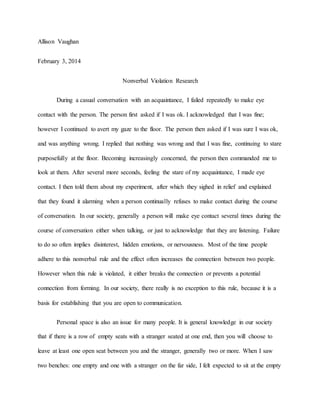
nonverbalviolationresearch
- 1. Allison Vaughan February 3, 2014 Nonverbal Violation Research During a casual conversation with an acquaintance, I failed repeatedly to make eye contact with the person. The person first asked if I was ok. I acknowledged that I was fine; however I continued to avert my gaze to the floor. The person then asked if I was sure I was ok, and was anything wrong. I replied that nothing was wrong and that I was fine, continuing to stare purposefully at the floor. Becoming increasingly concerned, the person then commanded me to look at them. After several more seconds, feeling the stare of my acquaintance, I made eye contact. I then told them about my experiment, after which they sighed in relief and explained that they found it alarming when a person continually refuses to make contact during the course of conversation. In our society, generally a person will make eye contact several times during the course of conversation either when talking, or just to acknowledge that they are listening. Failure to do so often implies disinterest, hidden emotions, or nervousness. Most of the time people adhere to this nonverbal rule and the effect often increases the connection between two people. However when this rule is violated, it either breaks the connection or prevents a potential connection from forming. In our society, there really is no exception to this rule, because it is a basis for establishing that you are open to communication. Personal space is also an issue for many people. It is general knowledge in our society that if there is a row of empty seats with a stranger seated at one end, then you will choose to leave at least one open seat between you and the stranger, generally two or more. When I saw two benches: one empty and one with a stranger on the far side, I felt expected to sit at the empty
- 2. bench. However I choose to sit instead on the occupied bench next to the stranger. Immediately after sitting down, I got an angry glance from the stranger, who then looked away, turning their body in the opposite direction from where I sat. I began shifting noticeably in my seat and then placed my rather large bag in between myself and the stranger, further encroaching on their space. The stranger attempted to shift further away from me, however realizing they were stuck between me and the end of the bench, decided to get up and walk away, possibly to return after I’d left. Most people choose to keep a polite distance from strangers and to place personal items on the ground or close enough to them so as not violate someone else’s space. When this rule is violated, it often evokes angry glances, attempts to regain personal space and establish boundaries by moving away, and after apparent frustration, the decision to leave the situation entirely. However there can be exceptions to this rule. In crowded situations, strangers are often forced to share personal space. This is acceptable because no one is deliberately violating someone else’s space. The situation is also different if two people are friends, rather than strangers, where it is then expected to share a bench. However, personal space exists even between friends. While talking to a close acquaintance, I continuously tried to make physical contact. During the conversation, I patted their hand, placed my hand on their knee, and touched their arm. The person looked to be extremely uncomfortable, but not wanting to be rude, attempted to politely shrug off my attempts at establishing a physical connection. Every time I made contact, the person visibly stiffened, flinched slightly, and moved away, signaling that they did not want to be touched. Typically, when talking to this person, we each maintain a polite, but friendly distance, and tend to maintain our own personal space. I was able to explain my research to this person, and ask for their feedback. They responded that the conversation was awkward and difficult to maintain due to
- 3. my repeated attempts at making contact. With acquaintances, it is unusual to make much contact until a friendship has further developed. This is a rule that is not always adhered to as some people are more contact driven than others, and it is often left up to the person on the receiving end to communicate whether or not the contact is ok. Failure to interpret a person’s nonverbal clues about wishing to maintain their personal space is often seen as aggressive and obnoxious. There are exceptions if both people are from a more contact culture where physical contact occurs more frequently between acquaintances or if the reason for the contact is more understood and not totally unexpected. After conducting my nonverbal experiments I realized how much we rely on nonverbal communication in our relationships with other people. I also learned how nonverbal behaviors can differ depending on relationships with different people. Friends are expected to sit closer than acquaintances, while it is normal in our culture to stay several feet away from strangers. Nonverbal communication is present in all our interactions with others and can communicate more than verbal communication can.